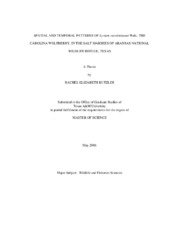| dc.contributor.advisor | Davis, Stephen E. | |
| dc.creator | Butzler, Rachel Elizabeth | |
| dc.date.accessioned | 2006-08-16T19:02:16Z | |
| dc.date.available | 2006-08-16T19:02:16Z | |
| dc.date.created | 2005-05 | |
| dc.date.issued | 2006-08-16 | |
| dc.identifier.uri | https://hdl.handle.net/1969.1/3758 | |
| dc.description.abstract | Understanding the salt marsh ecosystem in the Guadalupe Estuary is needed
because wetlands in this system support the endangered whooping crane (Grus
americana). The marsh plant research and monitoring described herein were based in
the salt marshes at Aransas National Wildlife Refuge (ANWR), which are utilized by the
cranes each winter. Past research indicates that the Carolina wolfberry (Lycium
carolinianum) contributes 21-52% of crane energy intake early in the wintering period
(Chavez 1996). Beginning in Fall 2003, vegetation transects were sampled along an
estuarine gradient at ANWR. Species diversity and composition was similar at the three
sites, with all sites containing the same 6-7 common species. While Spartina
alterniflora is only a minor part of this vegetation community, it dominates the few low
inter-tidal, fringe areas present. Species composition exhibited little variability from
Year 1 to Year 2 of the study. Densities and biomass of L. carolinianum were not
significantly different between sites or years. L. carolinianum, while important to salt
marsh ecology, accounts for only a small portion of the overall productivity. Based on
correlation coefficients, L. carolinianum was found in association with some of the common species in the vegetation community, indicating that its growth and survival
requirements are typical to the salt marshes at ANWR. Also beginning in Fall 2003, I
repeatedly sampled L. carolinianum in permanent plots along the estuarine gradient. L.
carolinianum exhibits strong temporal patterns. Leaf production peaked in early spring
and again just prior to peak berry abundance. Flowering of L. carolinianum occurred in
October and November. Peak berry abundance coincided with the cranesÂ’ arrival in late
October and early November. Berry production occurred in October, November, and
December; berries were virtually non-existent in the marshes for the remainder of the
year. Stepwise regression showed stem diameter alone was a good estimator of
aboveground biomass of this species in ANWR marshes, accounting for 94% of the
variability (p<0.001). Changes in aboveground biomass followed no distinct patterns in
the year of monitoring, perhaps due to the woody stem of the plant. Spatial patterns in
L. carolinianum were not explained by water quality parameters alone; it is suggested
that soil properties may help to account for the spatial variability. | en |
| dc.format.extent | 3155794 bytes | en |
| dc.format.medium | electronic | en |
| dc.format.mimetype | application/pdf | |
| dc.language.iso | en_US | |
| dc.publisher | Texas A&M University | |
| dc.subject | Lycium carolinianum | en |
| dc.subject | Carolina wolfberry | en |
| dc.subject | salt marsh | en |
| dc.subject | estuary | en |
| dc.subject | Aransas National Wildlife Refuge | en |
| dc.title | Spatial and temporal patterns of Lycium carolinianum Walt., the Carolina Wolfberry, in the salt marshes of Aransas National Wildlife Refuge, Texas | en |
| dc.type | Book | en |
| dc.type | Thesis | en |
| thesis.degree.department | Wildlife and Fisheries Sciences | en |
| thesis.degree.discipline | Wildlife and Fisheries Sciences | en |
| thesis.degree.grantor | Texas A&M University | en |
| thesis.degree.name | Master of Science | en |
| thesis.degree.level | Masters | en |
| dc.contributor.committeeMember | Slack, R. Douglas | |
| dc.contributor.committeeMember | Smeins, Fred E. | |
| dc.type.genre | Electronic Thesis | en |
| dc.type.material | text | en |
| dc.format.digitalOrigin | born digital | en |


